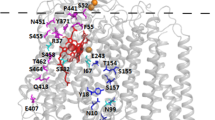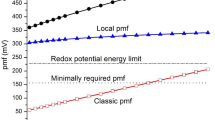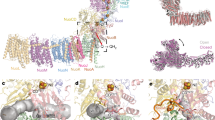Abstract
Cell respiration in mitochondria and some bacteria is catalysed by cytochrome c oxidase, which reduces O2 to water, coupled with translocation of four protons across the mitochondrial or bacterial membrane1,2,3. The enzyme's catalytic cycle consists of a reductive phase, in which the oxidized enzyme receives electrons from cytochrome c, and an oxidative phase, in which the reduced enzyme is oxidized by O2. Previous studies indicated that proton translocation is coupled energetically only to the oxidative phase4, but this has been challenged5. Here, with the purified enzyme inlaid in liposomes, we report time-resolved measurements of membrane potential, which show that half of the electrical charges due to proton-pumping actually cross the membrane during reduction after a preceding oxidative phase. pH measurements confirm that proton translocation also occurs during reduction, but only when immediately preceded by an oxidative phase. We conclude that all the energy for proton translocation is conserved in the enzyme during its oxidation by O2. One half of it is utilized for proton-pumping during oxidation, but the other half is unlatched for this purpose only during re-reduction of the enzyme.
This is a preview of subscription content, access via your institution
Access options
Subscribe to this journal
Receive 51 print issues and online access
$199.00 per year
only $3.90 per issue
Buy this article
- Purchase on Springer Link
- Instant access to full article PDF
Prices may be subject to local taxes which are calculated during checkout



Similar content being viewed by others
References
Wikström, M. Proton pump coupled to cytochrome c oxidase in mitochondria. Nature 266, 271–273 (1977).
Solioz, M., Carafoli, E. & Ludwig, B. The cytochrome c oxidase of Paracoccus denitrificans pumps protons in a reconstituted system. J. Biol. Chem. 257, 1579–1582 (1982).
Puustinen, A., Finel, M., Virkki, M. & Wikström, M. Cytochrome o(bo) is a proton pump in Paracoccus denitrificans and Escherichia coli. FEBS Lett. 249, 163–169 (1989).
Wikström, M. Identification of the electron transfers in cytochrome oxidase that are coupled to proton-pumping. Nature 338, 776–778 (1989).
Michel, H. The mechanism of proton pumping by cytochrome c oxidase. Proc. Natl Acad. Sci. USA 95, 12819–12824 (1998).
Babcock, G. T. & Wikström, M. Oxygen activation and the conservation of energy in cell respiration. Nature 356, 301–309 (1992).
Gennis, R. B. How does cytochrome oxidase pump protons? Proc. Natl Acad. Sci. USA 95, 12747–12749 (1998).
Verkhovsky, M. I., Belevich, N., Morgan, J. E. & Wikström, M. Proton linkage of cytochrome a oxidoreduction and proton translocation by the haem-copper oxidases. Biochim. Biophys. Acta (in the press).
Jasaitis, A., Verkhovsky, M. I., Morgan, J. E., Verkhovskaya, M. L. & Wikström, M. Assignment and charge translocation stoichiometries of the electrogenic phases in the reaction of cytochrome c with dioxygen. Biochemistry 38, 2697–2706 (1999).
Oliveberg, M., Hallén, S. & Nilsson, T. Uptake and release of protons during the reaction between cytochrome c oxidase and molecular oxygen: A flow-flash investigation. Biochemistry 30, 436–440 (1991).
Drachev, L. A.et al. Direct measurement of electric current generation by cytochrome oxidase, H+-ATPase and bacteriorodopsin. Nature 249, 321–324 (1974).
Hinkle, P. & Mitchell, P. Effect of membrane potential on the redox poise between cytochrome a and cytochrome c in rat liver mitochondria. Bioenergetics 1, 45–60 (1970).
Mitchell, R., Mitchell, P. & Rich, P. R. Protonation states of the catalytic intermediates of cytochrome c oxidase. Biochim. Biophys. Acta 101, 188–191 (1992).
Mitchell, R. & Rich, P. R. Proton uptake by cytochrome c oxidase on reduction and on ligand binding. Biochim. Biophys. Acta 1186, 19–26 (1994).
Armstrong, F., Shaw, R. W. & Beinert, H. Cytochrome c oxidase. Time dependence of optical and EPR spectral changes related to the ‘oxygen-pulsed’ form. Biochim. Biophys. Acta 722, 61–71 (1983).
Williams, R. J. P. Possible functions of chains of catalysts. J. Theoret. Biol. 1, 1–17 (1961).
Slater, E. C. Mechanism of phosphorylation in the respiratory chain. Nature 172, 975–978 (1953).
Acknowledgements
We thank the Academy of Finland, the University of Helsinki, and the Sigrid Jusélius Foundation for financial support, E. Haasanen for technical assistance and T. Aalto for glassware design.
Author information
Authors and Affiliations
Corresponding author
Rights and permissions
About this article
Cite this article
Verkhovsky, M., Jasaitis, A., Verkhovskaya, M. et al. Proton translocation by cytochrome c oxidase. Nature 400, 480–483 (1999). https://doi.org/10.1038/22813
Received:
Accepted:
Issue Date:
DOI: https://doi.org/10.1038/22813
This article is cited by
-
Structural insights into functional properties of the oxidized form of cytochrome c oxidase
Nature Communications (2023)
-
Thermodynamic efficiency, reversibility, and degree of coupling in energy conservation by the mitochondrial respiratory chain
Communications Biology (2020)
-
Structure of the intact 14-subunit human cytochrome c oxidase
Cell Research (2018)
-
The electron distribution in the “activated” state of cytochrome c oxidase
Scientific Reports (2018)
-
A chemically explicit model for the mechanism of proton pumping in heme–copper oxidases
Journal of Bioenergetics and Biomembranes (2008)
Comments
By submitting a comment you agree to abide by our Terms and Community Guidelines. If you find something abusive or that does not comply with our terms or guidelines please flag it as inappropriate.



